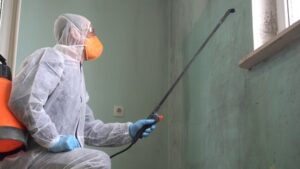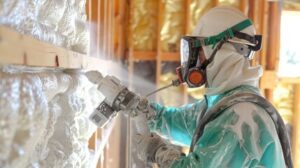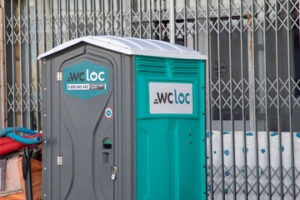When it comes to Mold Removal Salt Lake City you should always call in the professionals. Toxic mold spores like cladosporium and stachybotrys chartarum (commonly known as black mold) can cause respiratory issues and other health problems in people.

Mold remediation is a detailed process that involves several steps. Before any work begins, the area should be isolated and ventilated properly. Workers wear NIOSH-approved breathing protection, gloves and coveralls. All materials with mold spores are double-bagged in large plastic contractor cleanup bags and disposed of accordingly.
Molds thrive in moist and dark environments, spreading their spores in the air and attacking building materials and furnishings, destroying them quickly. They also produce allergens and irritants that can cause a variety of health problems, including respiratory irritation, allergies and skin problems. Exposure to even a few spores of some types of mold can be dangerous, especially for those with pre-existing conditions like asthma.
Mildew and similar molds that grow in damp, poorly lighted and poorly ventilated rooms such as basement recreation rooms, closets and shower areas can be a real nuisance. They leave a musty odor, discolor fabrics, rot and eat into leather and paper. Molds such as these are not a serious problem in new houses, but they can occur anywhere there is moisture and a food source.
Most common household molds can be eliminated with a little cleaning and sanitizing with hot water, dish soap and bleach. Larger problems will require a professional. If you do choose a professional, make sure they are certified by a reputable restoration company and follow government and industry guidelines.
A trained Mold Remediation Specialist should start by assessing the situation and what is required to fix it. This includes determining the extent of the infestation and looking at what is visible and what may be hidden inside walls or ceilings. They should also identify the type of mold that is present as some are more harmful than others. This step is very important because if the type of mold cannot be determined, it may not be removed completely and it will return.
In the next step, the mold remediation contractor will isolate the work area to keep spores from spread to other areas of the house or business. They will cover air supply and return vents in the area being worked on and use a fan to blow contaminated spores outdoors. They will wear rubber gloves and a face mask for safety. They will also use plastic or polyurethane sheeting to cover furniture, carpets and draperies in the affected area.
The next steps are misting and scrubbing non-porous surfaces and scrubbing porous surfaces with a stiff brush and hot water mixed with soap or a commercial cleaner. The area is then wiped down with clean towels and allowed to dry. Ventilation is very important, as the strong chemicals used in this process can create overwhelming fumes if not vented properly.
Symptoms
Certain types of molds produce substances that are dangerous for humans, including allergens and toxins. These materials can irritate the skin, eyes, nose, throat and lungs. They may also damage building materials, clothing and furniture. Common symptoms of exposure include sneezing, runny nose, congestion and coughing. People with asthma often experience more severe reactions. In addition, some molds may produce mycotoxins, which can be dangerous when inhaled or ingested. These are often found on damp building materials and insulation and can cause a variety of health problems. Some of the most harmful mycotoxins are produced by Stachybotrys, also known as black mold. This type of mold can grow on drywall, plywood, ceiling tiles, carpeting and tile adhesives. It releases spores that can contaminate the entire home and is associated with a variety of health problems, including respiratory issues and eye irritation.
The best way to determine if there is a mold problem in the home is to look for signs of a musty smell and discoloration. Stains or patches of dark color on walls and ceilings are indicative of a serious problem.
Professionals can clean most hard surfaces with a mild detergent and water or a solution of 1 cup of bleach to 1 gallon of water. Absorbent and porous materials, like drywall, carpeting and ceiling tiles, may have to be thrown away if they become moldy.
Mold spores contaminate the air, so it is important to remove all affected items and ventilate the area well during remediation. This step is essential to prevent the spread of mold spores throughout the home or business. Depending on the severity of the problem, professionals may use an EPA-approved biocide to kill mold spores and keep them from spreading.
The most important thing to remember during the cleanup process is that mold requires moisture in order to thrive. After the cleaning is complete, it is essential to fix the moisture problem that caused the mold growth in the first place. If the mold is not removed from its source, it will continue to return. Moisture can be controlled by scrubbing non-porous surfaces with detergent and water, or by fixing any plumbing leaks and drying them immediately.
Treatment
Depending on the type of mold and the surface it is growing on, there are many different treatments for it. If the mold is on non-porous surfaces, such as countertops or tile floors, it can usually be cleaned using a scrub brush and a mild cleaning agent or water. If it is on porous materials, such as drywall or ceiling tiles, it may need to be cut out and replaced. Once the mold is removed, it is important to fix any issues that could cause it to grow back. This includes fixing leaky faucets and making sure the area is completely dry.
If the mold is spreading rapidly, it may be a sign that there is a larger moisture issue that needs to be addressed. In this case, a professional mold remediation company should be called. They can use specialized equipment and techniques to get the area mold free and prevent it from coming back.
A trained mold removal specialist will come to your home or business and perform a detailed inspection of the affected areas. They will look at the size of the mold growth, how deep it is and where it is located. They will also test the air to see if there are any spores that need to be killed.
They will then isolate the area to prevent the spread of spores and begin the cleanup process. This process may include removing and replacing the materials that are affected, scrubbing the area with a disinfectant and then cleaning it using a high-powered vacuum cleaner. They will also use HEPA filters to clean the air and remove any lingering mold spores.
If the mold is in a very large area, it may be necessary to have a reputable mold remediation company come out and do a more thorough job of removing the spores and returning the area to normal. They can use a special chemical that is approved by the EPA to kill all the mold spores in the space. This will be followed by a process of drying the area and then applying a protective coating to prevent it from growing again in the future.
Prevention
Whether it’s slimy black spots on the shower curtain or fuzzy white patches on your basement floor, household mold can cause problems. It’s not just unsightly; it can make people sick, especially if they have allergies or asthma. Even if you are not allergic, breathing in airborne mold spores can irritate your eyes, skin and throat.
Prevention is the key to controlling mold growth in your home. Keep humidity levels in your home below 50% all day long, and use dehumidifiers and air conditioners if necessary. Make sure there are no leaks in your roof, walls or plumbing; and fix them promptly. Don’t store porous materials that have been wet for more than 48 hours, including carpeting and rug padding, wallpaper, ceiling tiles, insulation material and wood products.
If you have mold that has already developed, act quickly to clean and dry the area. The longer the mold remains wet, the more damage it causes. If you are cleaning up the mold yourself, use safety goggles and rubber gloves and wear a mask when using chemical cleaners like bleach or other biocides. Avoid breathing in fumes and open windows to provide fresh air during cleanup.
For large areas of mold growth, the CDC recommends hiring a professional who has experience with cleanup and remediation. Check for references and ask the contractor to follow recommendations in EPA’s guide, “Mold Remediation in Schools and Commercial Buildings,” or guidelines from other professional or government organizations.
Many experts agree that testing for the type of mold is usually unnecessary. It is more important to clean up the mold and prevent it from returning. However, if you have a lot of mold and are worried about health effects, test for mycotoxins (poisons produced by some molds) in the food you eat, such as corn, peanuts, cottonseeds, tree nuts and wheat. Some types of these mycotoxins have been linked to liver cancer in farmers and workers who handle the crops. But such toxins are not common in household foods. A thorough cleaning and drying of affected materials should remove any traces of mycotoxins.








